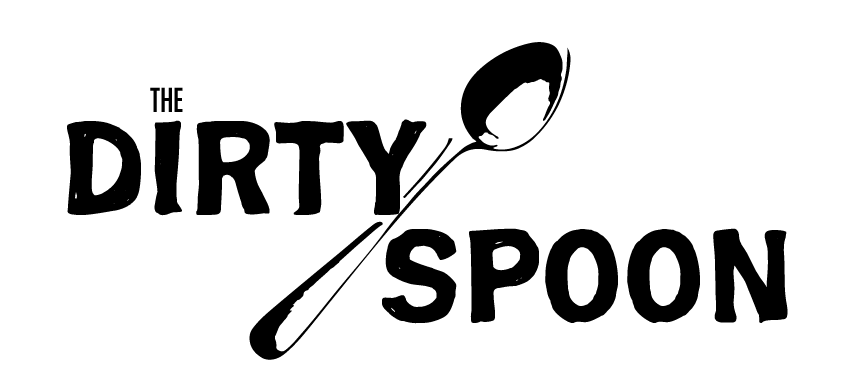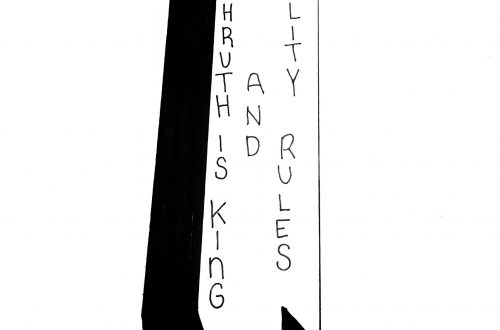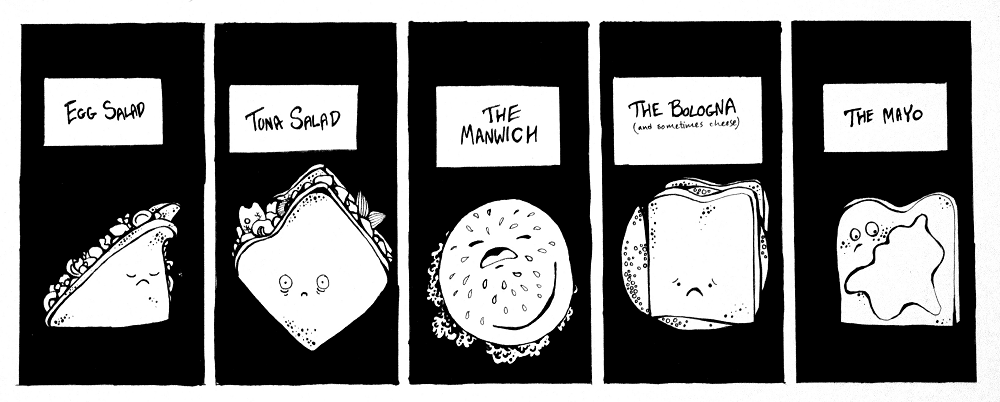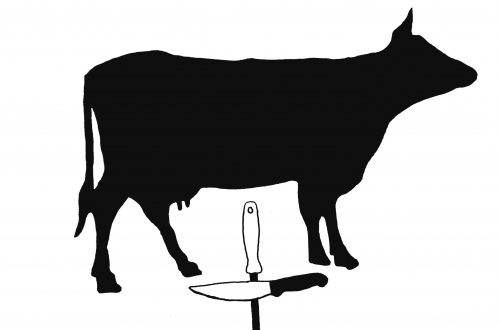by Kim Freeman
Kim’s essay appears in episode 24 of The Dirty Spoon Radio Hour.
Imagine if you tuned into The Beverly Hillbillies one day and saw Elly May rejecting Granny’s vittles after spying ham hock bits floating in the dandelion greens. She looks at her family, picks up her pet chimpanzee, and announces she no longer “eats anything with a mama.” You can picture the reaction, especially from Jed who made their fortune “shootin’ at some food, and up through the ground came a bubblin’ crude.”
Take away the ridiculousness of that premise, the mansion, the chimpanzee, and so forth, but keep a family steeped in the Appalachian tradition of hunting and eating meat hearing a few years ago that their daughter went vegan.
If my Kentucky family measured pronouncements like earthquakes, adopting veganism was just slightly less on the “moment magnitude scale” than the “Guess Who’s Coming to Dinner” reveal of my soon-to-be husband, Clayton, several months earlier. Resulting damages included being kicked off the 125-person guest list for my stepfather’s 70th birthday. It was explained we’d be a “distraction.” An interracial couple at a party in Lexington in 2015 was apparently more than the genteel folks could handle. Fortunately, on that topic they have fully repented. Now, my 76-year-old mother is a staunch anti-racist ally and gives no quarter to those who aren’t.
To be fair, it was understandable that they thought giving up meat and dairy was as unnatural as a two-headed frog. For more than 50 years I had happily consumed animal products. As had my husband, a phenomenal self-taught cook.
In our first couple of years of marriage, Clayton fattened me up – feeding me is one of his love languages – on fork tender baby back ribs smothered in his special BBQ sauce, ham hock infused greens (a favorite apparently not reserved for hillbillies), and to-die-for macaroni and cheese. He explained to me early on there’s few culinary topics as serious as mac and cheese in the Black community. His dish contained at least four varieties of cheese, perfectly cooked elbow macaroni, just the right amount of seasoning–never measured, of course–and then baked until the top bubbled up into spots of golden brown. And never, ever was mac and cheese served without being baked. That was straight up ancestral blasphemy.
In our first couple of years of marriage, Clayton fattened me up – feeding me is one of his love languages – on fork tender baby back ribs smothered in his special BBQ sauce, ham hock infused greens (a favorite apparently not reserved for hillbillies), and to-die-for macaroni and cheese.
As a daughter of Appalachia, my father hunted in the Eastern Kentucky hills and often brought home wild game, the variety depending on the season. Because squirrel season was one of the longest, I have vivid memories of sacks filled with buckshot riddled squirrels. He skinned them on the front deck of our creek-side home, sometimes preserving the pelts or the bushy tails. With the point of a small bone-handled knife, he cut off the head and slit open the chest cavity to pull out the tiny organs. Then he laid their slender naked bodies marked with pinprick crimson-rimmed holes on a nearby table. My older brother hunted, too. He took an academic approach to the sport, telling us that during his first year at Princeton he studied squirrel movements from his dorm room window. We chuckled about him needing an Ivy league education to outsmart tree rodents with brains the size of the walnuts they gathered each fall.
It takes a lot of squirrels to make a meal.
My mom, tasked with critter cooking, would freeze them until an annual wild game feast we hosted at our log cabin guest house that was nestled against the backyard hillside. Game of all kind was served, including local favorites such as grouse, quail, turkey, deer, squirrel, rabbit, and groundhog, and more exotic big game like moose, elk, and Canadian goose from hunting trips out West or up North. Squirrels and rabbits were fried and served in a gravy made of flour, milk, salt, pepper, and the skillet scrapings left in the cast iron frying pan. Both required some care while eating to avoid cracking a tooth on a stray pellet.
Our modest ranch style home and the backyard log cabin were filled with hunting trophies. From mounted glassy-eyed deer heads and silky soft rabbit pelts to a stuffed grouse frozen forever with its wings spread to take flight, we were surrounded by these death relics. I never thought much of it or the number of animals I witnessed being skinned, gutted, and dressed. Upon reflection, it seems a fitting atmosphere mirroring the emotional and verbal violence my father inflicted upon us. Undoubtedly, were he not already dead, my veganism would have been met with thunderous vitriol and vicious mocking. My Black husband would have hastened his eternal dirt nap.
Given the amount of diverse meat I consumed growing up in the hills and clearly being numbed to animal slaughter that was woven through childhood, my transition to veganism was improbable.
Given the amount of diverse meat I consumed growing up in the hills and clearly being numbed to animal slaughter that was woven through childhood, my transition to veganism was improbable.
When it occurred, skepticism—even derision—was expected. But our decision was multi-layered.
After doing some research, we felt giving up meat and dairy was best for our health, the environment (including animals), and could be an outreach to minority communities. It is no secret that racism permeates the U.S. healthcare system leaving Blacks and other people of color with the highest rates of heart disease, diabetes, high blood pressure, and stroke, which results in lower life expectancies and poor quality of life. We’ve seen the evidence of these inequities recently as COVID-19 has disproportionately killed minorities. Unarguably, better nutrition could help.
My husband long shunned what he calls “slave food,” including chitterlings, pig and chicken feet, oxtails and neck bones, or any dishes deep fried and overly salted. Prior to embracing veganism, we already ate a lot of vegetables and fruit, so the transition wasn’t difficult when combined by his cooking skills.
We did it overnight. One day omnivores; the next day herbivores.
We get a lot of questions like “How do you get enough protein?” and “But what do you eat?” People are surprised when we explain there’s protein in plants. As for what we eat, we consume everything but animal products. Everything includes about 90,000 edible plants plus a plethora of vegan substitute meat and cheese products made from…wait for it…plants.
As we dove into our new lifestyle, Clayton did what he does best: make delicious food. We’d share with family and friends, including the hillbilly relatives, and were universally met with rave reviews and the repeated comment “Can’t believe it’s vegan!”
He kept churning out fantastic plant-based food, experimenting with flavors and techniques, and using my co-workers as his taste testers. All the while, I watched his passion for vegan food grow as he focused on what this could mean to his community. I started encouraging (perhaps pestering) him to make it a business. It took me months to convince him, finally winning him over on an anniversary trip to Maui. “And I know what to call it,” I told him as we walked the beach, “Can’t Believe It’s Vegan!”
We came home and announced we were starting an all-delivery vegan food business.
Besides introducing people to the best vegan food in Central Ohio, we’ve remained dedicated to educating African Americans on veganism and how plant-based eating is their real culinary heritage. We are heartened to see veganism is catching fire with minority communities as people embrace their roots and focus on bettering their health. Then the world turned upside down from a global pandemic requiring lockdown orders, shutdowns, and social distancing. But our little all-delivery business has survived so far.
Besides introducing people to the best vegan food in Central Ohio, we’ve remained dedicated to educating African Americans on veganism and how plant-based eating is their real culinary heritage.
If this story were a Lifetime movie, it would end with my hillbilly kinfolk coming to some epiphany about veganism. We’d snack on some roasted red pepper hummus and laugh about their initial resistance. At best we just don’t talk about it, like Vegan Fight Club. They still enjoy my husband’s cooking and support our business from afar, yet we know some shake their heads and struggle to understand. But we remain committed to our choice and like our hypothetical Elly May, plan on living our remaining years refusing to eat anything with a mama.
Custom illustration by Corinne Pease.
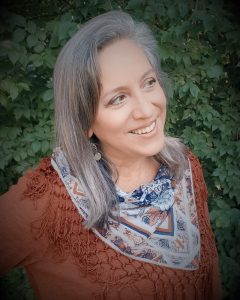
About Kim Freeman
Kim Freeman is a former award-winning journalist turned lawyer who has hundreds of published articles, essays, and short stories. She and her husband enjoy a vegan lifestyle in Columbus, Ohio. When not tempting (torturing?) her hillbilly relatives with plant-based goodness, she is a social justice advocate dedicated to ending systemic racism.
